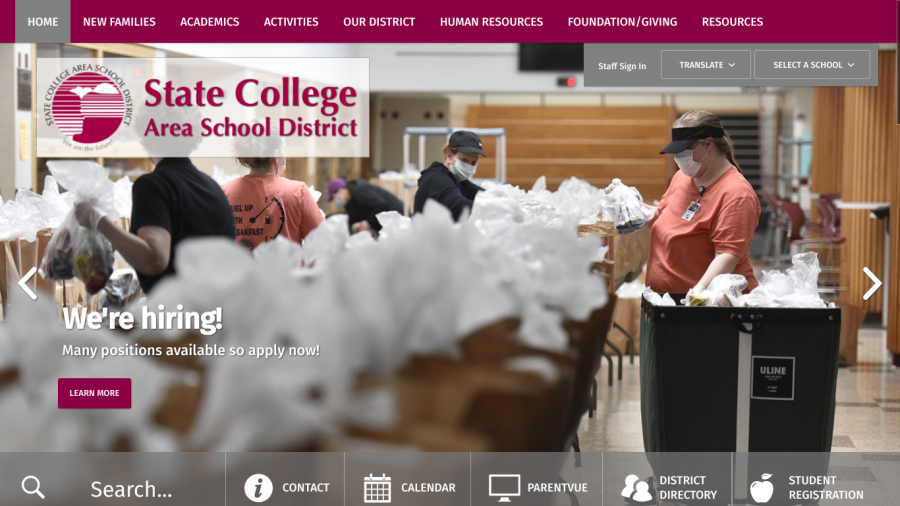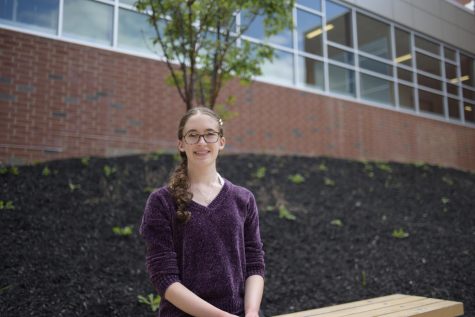Substitute Teacher Shortage Affects State High
Pictured on Nov. 9, a large banner photo on scasd.org encourages viewers to seek more information about the district’s job openings, including substitute positions. Upon clicking the maroon “Learn More” button, viewers are directed to a site from which they can scroll through job listings and apply.
November 29, 2021
Keeping in sync with recent national labor trends across the education sector and others, State College faces a districtwide substitute teacher shortage. The State College Area School Board approved a pay raise for substitutes last month in an attempt to garner interest for open positions, but State High still feels the shortage’s effects, especially in the writing, math, and testing centers.
In mid-October, the school board unanimously decided to raise substitutes’ daily pay $10, from $95 to $105. District retirees’ daily pay increased from $125 to $135. As an additional incentive, daily wages for non-district retirees now increase to $120 following 20 days worked.
Retired art teacher and long-time SCASD substitute Wanda Pluto reacted positively to news of the pay increase, appreciating how the additional compensation acknowledges the sometimes difficult nature of subbing.
“That’s good because we don’t get all the benefits, we don’t get all the perks of a full-time teacher,” Pluto said of the school board’s decision. “And sometimes, we find ourselves in some pretty weird situations, and we don’t know the students as well, so we’re really going in blind on some occasions.”
The district’s call for help from the community was met with some success: as of Nov. 5, the head of human resources reported 62 responses to substitute position ads and 16 new subs approved by the school board on Nov. 1, with ten of them qualified to fill in for teachers, according to State High English teacher Allison Becker.
The response to the district’s substitute advertisement is predicted to grow, but for now, its impact is yet to be felt by building substitutes (subs who currently work exclusively in one SCASD building, such as State High) and teachers alike.
Math-certified State High building sub Kenneth Cherry has found his schedule to be busier now than before the sub shortage. Previously, Cherry had occasional days off throughout the week when he had time to himself, but he now comes in every day since there is always bound to be an opening somewhere in the school.
The days can be overwhelming, but “you get used to it,” Cherry said. “It’s nice if you’re looking for constant work as a sub. You have a place you can go…there’s always gonna be somewhere that needs a role filled. But if you’re a person [who]’s looking to sub part-time, you don’t really get that luxury—that pressure’s on you constantly to be somewhere because there’s such a need for it.”
Cherry has had to jump between different roles in a day, covering for one teacher during blocks one, two, and four, for example, and then for someone else during block three. He is often fortunate to fill in for math teachers, his area of expertise, but he acknowledges that this is not the case for all subs.
“Being all over the place—it can definitely be challenging, especially if it’s not in an area that’s your specialty,” Cherry said.
Similar to Cherry, Pluto is often called to substitute in her area of knowledge: art. She typically works half days, out of her own preference, and comes in a few days a week.
“When there’s off periods, sometimes the office does have to juggle us to fill in spots,” Pluto said. “I’m really flexible, so it doesn’t bother me at all.”
Pluto has not had a stressful experience subbing this fall, and she enjoys coming out of retirement to spend time in the classroom.
“I’m not real busy, because the teachers are very good at leaving work for the students through Canvas,” she added. “I do very little teaching if anything.”
Newly-hired district substitute and recent Penn State graduate Aaron Marrie found that subbing allowed him to earn an income while putting his bachelor’s degree to use, even though he did not go into teaching. Marrie started subbing just as the pay raise was implemented, and though he will work toward accumulating 20 days of work, the increase was not what drew him to the position. Marrie commented on how and when he receives his substitute assignments.
“Usually, I like to pick the people that I [fill in for], but I have gotten phone calls starting at 6:30 in the morning or instances [where] once I’m in the building, they’re going to change up what I do,” Marrie said.
During his first few weeks of subbing, Marrie figured out which daily schedules he prefers. Like Cherry, he sometimes fills in for multiple teachers on the same day.
“Today, for example, was better balanced, I would say,” Marrie said on Nov. 5. “I like this schedule. I had two classes in the morning, then I had my prep and my lunch…and then I have one more class that goes out through the end of the day, and then I’m done.”
Marrie finds schedules like his Nov. 5 one more relaxing as compared to monitoring a gym class (where he must make sure no students get hurt) or a study hall (where he ensures that students are on task).
The substitute shortage additionally affects teachers. Though math teacher Erol McGowan doesn’t frequently need a substitute himself, he mentioned that it is challenging when the office staff has to “piece together” an assortment of subs to fill in for a single teacher.
“It’s difficult as a teacher when you’ve had three different people covering your classes,” McGowan said. “There’s no coherence to that.”
Becker’s experience further illustrates the impact of the substitute shortage on teachers. Becker is not used to subbing, except for on rare occasions, but due to the shortage, she has been called to fill in in various classes at a moment’s notice—sometimes 10-15 minutes ahead of time.
“The substitute shortage has affected me mostly because I have been pulled from the writing center first block on B days to cover for other teachers because they don’t have a sub,” Becker said. “So, we have to close the writing center and close the testing center (I do 45 minutes in one and 45 minutes in the other). We have to close both of those, and they just put you in these classes—like I got to sub for Fashion and Design Technology, but I don’t know how to use a sewing machine. I was put into a…Multi-Tiered System of Support class. That means that we’re dealing with students that have very severe learning and intellectual disabilities, and I loved it, but I’m not trained—I’m not a special education teacher. I’m not trained in certain things. So, it makes your day a little bit more stressful.”
The exclusively teacher-run writing, math, and tutoring centers are helpful resources for students, and the frequent closings of the centers (due to teachers like Becker being pulled from their usual duties) dampen the resources’ efficacy and reliability. Becker often directs her students to the writing center, especially toward the end of marking periods, to improve their writing grades by looking over feedback, rubrics, and the like with the help of an English teacher. However, with the center’s closure, she can no longer guarantee that a teacher will be available there.
“During my prep time…I wouldn’t be able to grade papers or prep for next week or put things on Canvas because I’m having writing conferences with students who couldn’t have writing conferences in the writing center because it was closed,” Becker explained.
Thus, not only has Becker’s duty changed from working in the writing center to subbing for various classes outside of her area of expertise, but her prep period diminishes as she aims to meet students’ needs.
The closing of the three centers also presents a hurdle from a student perspective.
“It’s been hard to get retests done and go use the testing center because most of the time, they don’t have a teacher to staff it,” junior Casidy Cohagan said.
Often, students do not find out that any one of the centers are closed until they arrive, which disrupts plans that students and teachers make ahead of time.
McGowan has been affected by his students facing testing center closures. Also, as a result of the shortage, McGowan has been pulled to sub, including during his duty time. Unlike Becker, though, McGowan commented that he has received notice a day prior to being called to sub. McGowan expressed his appreciation for the staff tasked with assigning substitute teachers.
“I don’t envy the people who have to assign the subs—I don’t envy them at all,” McGowan said. “It’s a really hard job they’re doing right now. And I know they’re hearing about pulling people from the testing center…I get it; they’re doing what they have to do.”
The current substitute shortage—which stems from a national, systemic problem—causes disruptions in the classroom. With students, teachers, substitutes, and staff feeling its effects, the school district is hopeful that an increase in substitute pay coupled with a call for help from the community will encourage an influx of substitute job applications.
“Subbing’s a nice way to get in the district and get to know people in the district, so it’s still an avenue for people [who] really want to teach around here,” Cherry said.
However, Cherry notes that the many requirements for becoming a substitute, such as a bachelor’s degree or teaching certificate, clearances, school vaccines, and child abuse training, might turn some applicants away. Considering this, the district faces an uphill battle in its attempt to grow its substitute pool.
State High principal Laura Tobias was not available to comment. The State High building secretary in charge of substitute coordination recently changed positions to office budget secretary and declined to comment.



